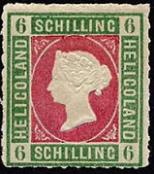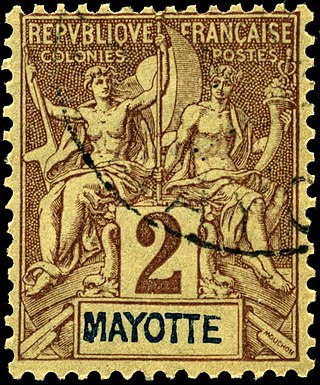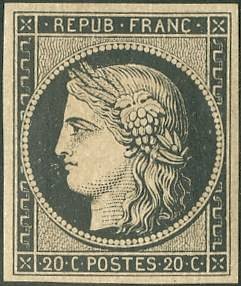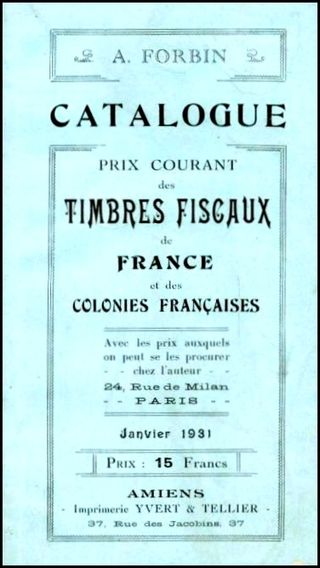
Philatelic literature is written material relating to philately, primarily information about postage stamps and postal history.

A stamp catalog is a catalog of postage stamp types with descriptions and prices.

The Mauritius "Post Office" stamps were issued by the British Colony Mauritius in September 1847, in two denominations: an orange-red one penny (1d) and a deep blue two pence (2d). Their name comes from the wording on the stamps reading "Post Office", which was soon changed in the next issue to "Post Paid". They are among the rarest postage stamps in the world.

Jean-Baptiste Philippe Constant Moens was a Belgian philatelist recognized as the first dealer in stamps for collectors. He was one of the original philatelic journalists.

This is a survey of the postage stamps and postal history of Romania.

During the period when Heligoland was a British possession, about 20 postage stamps were issued between 1867 and 1890. There were up to eight printings of a single denomination and also a large volume of reprints which are known as the Berlin, Leipzig and Hamburg Reprints, respectively. The Berlin reprints are sometimes better quality than the originals. The reprints were done between 1875 and 1895. Consequently, many "old" collections contain reprints rather than originals. Some believe there were seven million reprints as compared to the known 1½ million originals, of which perhaps half were sold through the post office and the remainder sold to dealers when withdrawn from use. A few printings were never postally sold but nevertheless found their way into the hands of dealers. The stamps were printed by the Prussian State Printing Office in Berlin. They were denominated in the Hamburg Schilling until 1875, when both German Reich and British values appeared on each stamp issue. All are embossed with a silhouette of Queen Victoria excepting the four highest values which represent Heligoland escutcheons.

The Chalon Head is the name of a number of postage stamp series whose illustration was inspired by a portrait of Queen Victoria by Alfred Edward Chalon (1780–1860).

This is an overview of the postage stamps and postal history of the Indian Ocean island of Mayotte, one of the Comoros Archipelago islands located on the south-east side of Africa.

The Ceres series was the first postage stamp series of France, issued in 6 different values from 1849 to 1850 as a representation of the French Republic.
Anatole Auguste Hulot was a French civil servant who directed the designing and printing of the first postage stamps of France between 1848 and 1876.

Oscar François George Berger-Levrault was a French philatelist. The invention of the stamp catalogue is attributed to him and to the Englishman, John Edward Gray.
The Académie de philatélie is a French philatelic voluntary association created in 1928. Its goal is to promote philately and philatelic studies.
The Bureau d'études des postes et télécommunications d'outre-mer was a French public institution, financially autonomous. Linked to the French Minister of Cooperation, its goal was to help in the postal and telecommunication areas the French Overseas territories and the newly independent states that asked for it. It operated from 1956 until late 1994.

The postal history of Monaco can be traced to the principality’s first postmark in 1704. Stampless covers are known with both manuscript and handstamp postmarks for Monaco and Fort d'Hercule ; as the principality was once much larger, postmarks of the communes of Menton and Roquebrune prior to their 1848 secession might also be included. Monaco used Sardinian stamps from 1851 until 1860, when by the Treaty of Turin, Sardinia ceded to France the surrounding county of Nice and relinquished its protectorate over Monaco; French stamps with Monaco or Monte-Carlo postmarks were used thereafter. Two forms of cancellation are known for the French period. With the first, the postmark is on the cover away from the stamps; an obliterator with an identifying post office number 4222, or later 2387, inside a diamond of ink dots cancelled the actual stamps. The second applied the postmark directly on the stamps, as both a date stamp and cancel. All of these postal forerunners, particularly usages of Sardinian stamps with Monaco cancels, are far more valuable than the same stamps postally used in the issuing countries.

Alfred J. Forbin was a pioneering French stamp dealer who wrote an all-world catalogue of revenue stamps that has never been surpassed.

Frederick William Booty was an English artist from, who was also the author of the first postage stamp catalogue in English, and the first illustrated stamp catalogue anywhere.
This is a survey of the postage stamps and postal history of the Democratic Republic of the Congo, formerly Zaire and the Belgian Congo.

The Crawford Library is a library of early books about philately formed between 1898 and 1913 by James Lindsay, 26th Earl of Crawford. By the time of his death in 1913, Crawford was thought to have amassed the greatest philatelic library of his time. Today, the library is part of the British Library Philatelic Collections.

The Greek god Hermes, messenger of the Gods in the Greek mythology, is the representation chosen, in 1860, by the Kingdom of Greece to illustrate its first postal stamps.















